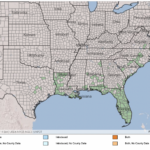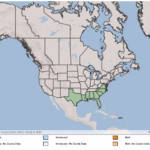Eleocharis baldwinii
USDA, NRCS. 2018. The PLANTS Database (http://plants.usda.gov, 28 March 2018). National Plant Data Team, Greensboro, NC 27401-4901 USA.
Illustration courtesy of University of Florida/IFAS Center for Aquatic and Invasive Plants. Used with permission.
What is Baldwin’s Spikerush?
Physical Characteristics
Leaves:
- Sheaths mostly reddish in color
- Strong green midnerve
- Sword- or elliptical-shaped
- 0.13-0.17 inches long
Flowers:
- Mostly at the base of the plant
- Elliptical-shaped
- 0.16-0.28 inches long
- 5-10 flowers
Fruit:
- Egg-shaped
- 0.02 inches long
- Whitish-olive or olive brown in color
- 3 corners
- Smooth
- One-seeded
- Does not open to release seed when ripe
Stem:
- Hollow stem
- 2.36-7.9 inches long
- About 0.02 inches thick
Where Does it Grow?
Baldwin’s spikerush can be found in soft, muddy ground and around pools.
Pros and Cons of Baldwin’s Spikerush
Docks, geese, muskrats, and nutria all eat portions of spikerush from seeds, to rhizomes and tubers. Submerged portions of all aquatic plants provide habitats for many micro and macro invertebrates. These invertebrates in turn are used as food by fish and other wildlife species (e.g. amphibians, reptiles, ducks, etc.). After aquatic plants die, their decomposition by bacteria and fungi provides food (called “detritus”) for many aquatic invertebrates.


